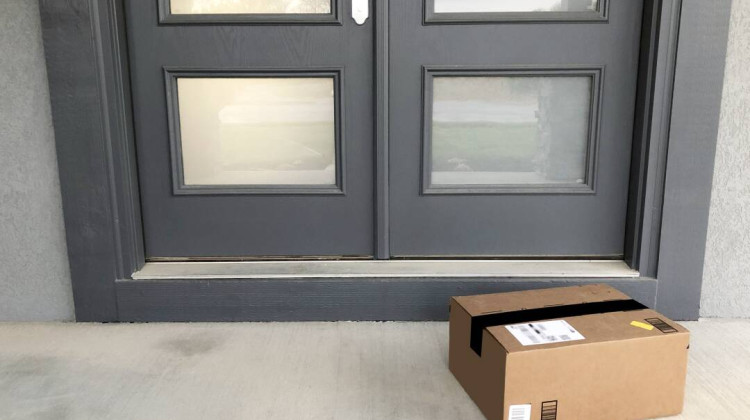
Many policy experts point to a permanent Child Tax Credit, made available to low- and no-income families, as an effective strategy for reducing child poverty.
Tina Floersch / UnsplashMaxine Thomas got her first Child Tax Credit payment in the spring of 2021. She was skeptical, like it was too good to be true.
“I really didn’t think I was going to get it for some reason,” she said.
Thomas is a single mom of five children. She works full time at a food bank in Indianapolis.
The temporary expansion of Child Tax Credits under the American Rescue Plan made the payments available to low- and no-income families for the first time, and it increased the amount provided. Families could receive monthly payments of $250 for each child between the ages of 6 and 17, and $300 for each child under the age of 6.
Since the pandemic had forced schools to close, Thomas’ children were home every day, which drove up the costs of food and other bills. So the payments came at the right time. Thomas received $1,000 a month – a $250 credit for each of her children at home.
“The child tax credit was able to fill a lot of financial gaps,” she said. “Just being able to help keep food home, paying on my utility bills that were ever-rising, because we were home full-time all the time.”
Critics of the expanded Child Tax Credit cautioned that the move would disincentivize work, but data shows it had the opposite effect. The money helped with things like child care and transportation expenses, allowing more people to invest in their own businesses, work, pay off debt and go back to school.
About 70 percent of families spent the credit on routine expenses like food and utilities, according to research from the Brookings Institute. The temporary expansion lifted 3.7 million children out of poverty, as of December 2021.
When the expanded Child Tax Credit went away in January of this year, child poverty skyrocketed again.
As many states, including Indiana, take steps to tighten abortion laws, conversations have been reignited about how to best support families and babies. And many policy experts point to a permanent child tax credit, made available to low- and no-income families, as one way to do that.
Many families that were helped are struggling again
The child tax credit expansion reduced food insufficiency by 26 percent in 2021, according to Allison Bovell-Ammon, who has studied the issue.
“Food insecurity not only affects a child's physical health or physical growth, but also their cognitive development, their ability to focus and do well in school to really reach their highest potential,” said Bovell-Ammon, director of policy and communications with Children's Healthwatch at Boston Medical Center. “Even brief periods of disruption of access to food can have really lasting impacts on a child's ability to grow and to be healthy.”
Those disruptions can negatively affect overall life outcomes.
Food insufficiency and insecurity disproportionately burdens Black and Latino families, as well as single adult families. Research indicates these same populations were hit hardest by the expiration of the child tax credit payments at the start of this year, Bovell-Ammon said.
For Thomas, the mother of five, the expiration of these payments has made life more difficult. She had to start making sacrifices -- like when her sons were going back to school and they needed new clothes.
“It seemed like everybody just sprouted out at the same time,” Thomas said. “I felt it when it was kind of tough, juggling who to go and get new shoes for.”
In the month after the credits expired, 3.7 million more children entered poverty. The child poverty rate rose from 12 percent in December 2021 to 17 percent in January 2022. Food insufficiency rates increased by approximately 25 percent among families with children from January to July of this year, according to a study from the Boston University School of Public Health.
That’s a big reason why many are advocating to bring the credit back – and make it permanent. Doing so would lift people out of cyclical poverty, said David Plasterer, a senior policy associate with Results, a national advocacy group in support of the child tax credit.
“When you're experiencing poverty, job loss is fairly routine. You get into a job and you think, OK, well, this is going to be the one.’ Then your car breaks down, or you lose your housing, or a kid gets sick, and you get fired because you couldn't go into work,” Plasterer said.
A permanent child tax credit would help people overcome these obstacles to stable employment.
“It would allow families to get more financial stability and increase their earning capabilities long term,” Plasterer said.
Who benefits from the credit
For years, the child tax credit has been available to families that meet income and other requirements.
Without the child tax credit expansion, families earning less than $2,500 annually are not eligible. People making more than $2,500 a year are eligible for a few cents on every dollar they make above that – up to $2,000 per child age 16 and younger for families making at least $30,000 a year. The credit begins to phase out once a family’s income level surpasses $200,000 a year for single filers, or $400,000 a year for joint filers.
These income requirements are based on the idea that an eligibility threshold would encourage people to work more and increase their earnings.
The temporary expansion of the Child Tax Credit in 2021 made the full tax credit available to low- and no-income households for the first time. Without the expansion, an estimated 27 million children are excluded from the full child tax credit because their families didn’t earn enough money.
This is the opposite of how it should be, Plasterer said. Families with the lowest wages are eligible for the least amount of money, and often none at all.
“There's married couples out there making $400,000 a year that are getting the full value of the credit,” Plasterer said. “And there are single parents that are working part time, making $15,000 a year,” who are eligible for only a fraction of the full credit.
“So you basically have to lift yourself out of poverty before you're eligible for the Child Tax Credit, which makes zero sense,” he said.
Plasterer, and many other advocates for a permanent expansion of the child tax credit program, say work and income requirements unfairly hurt children and families.
“There are a lot of people in this country who are supporting children, who are unable to work for a number of reasons,” said Bovell-Ammon, the researcher with Children’s HealthWatch. “Or they are between jobs or having a hard time working and we really shouldn't be punishing children by leaving them out of this incredible benefit that has been shown to have such profound impacts on abilities for children to have their basic needs met.”
In the era of abortion bans, what’s being done to support vulnerable families?
Many Indiana lawmakers who voted for the abortion ban – now on hold due to legal challenges – have also said they want to increase support for mothers and babies.
State Rep. Sharon Negele (R-Attica) is a leader in Indiana’s efforts to financially support mothers and families. She says this became especially important when the near-total abortion ban, which she supported, was signed into law.
“I don't think you can just outlaw something without making sure all of those other variables are in place. So we tried this last special session, but it's not perfect,” she said.
Negele said she will be pushing for more support for mothers and families in the next legislative session, such as making birth control more accessible and child care more affordable. Negele did not say whether she would be in support of a state-sponsored, permanent child tax credit.
“If we want to encourage people to have babies, we need to make it as affordable and as maybe incentivized as much as possible,” Negele said. “We know as a society that growing our population base is important. And we just have to make sure that we are giving everybody that proper opportunity.”
Outside of her full-time job with the food bank, Maxine Thomas also works with Experts on Poverty, an advocacy group that employs people with first-hand experience navigating federal safety net initiatives like the Supplemental Nutrition Assistance Program and tax credit programs.
Thomas has spoken about her experience with both lawmakers and community members. She’d like to see lawmakers make the credit permanent without a work or income requirement.
“When we put stipulations on who is deemed eligible or good enough to get these types of credits and refunds, I think it removes the human dynamic of humanity,” Thomas said. “I know that [the credit] has lifted families and children out of poverty, and that should be the ultimate goal.”
A handful of states – including California, New Jersey and New Mexico – have introduced or expanded state child tax credits in the past year. In Indiana, conversations among lawmakers and advocates are taking place but are in the early stages.
Parents who didn’t receive the 2021 child tax credit payments can still claim them online at getctc.org before Nov. 15.
This story comes from a reporting collaboration that includes the Indianapolis Recorder and Side Effects Public Media — a public health news initiative based at WFYI. Sydney Dauphinais is an economic equity reporter at WFYI. Follow her on Twitter: @syddauphinais.
9(MDAyMzk1MzA4MDE2MjY3OTY1MjM5ZDJjYQ000))
 DONATE
DONATE






 Support WFYI. We can't do it without you.
Support WFYI. We can't do it without you.